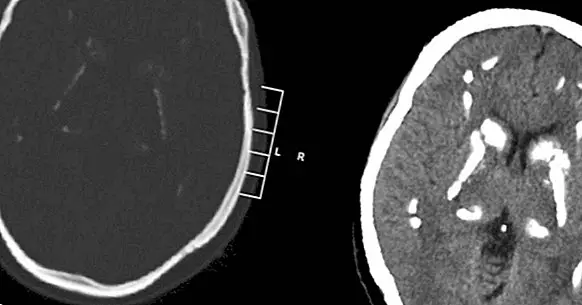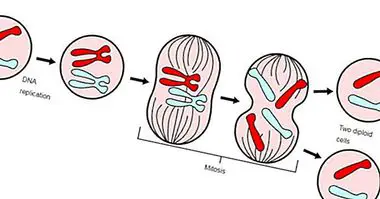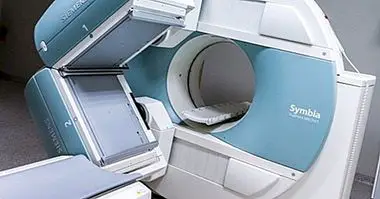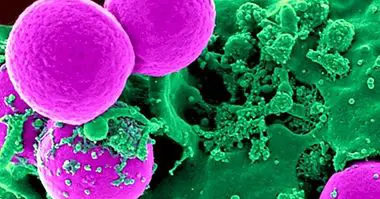Fahr's disease: what it is, main causes and symptoms
Fahr's disease consists of pathological accumulation of calcium in the basal ganglia and other subcortical structures. This phenomenon causes symptoms such as parkinsonian tremors, loss of motor skills, progressive cognitive deterioration and typical alterations of psychosis, such as hallucinations.
In this article we will analyze the main causes and symptoms of Fahr syndrome . However, it is a very rare disease, so the knowledge that exists about it at present is limited; This could also be one of the reasons that there is no treatment for the syndrome.
- Related article: "The 18 types of mental illnesses"
What is Fahr syndrome?
Fahr syndrome is a neurodegenerative disease of genetic origin that is characterized by Progressive bilateral calcification of the basal ganglia , a set of subcortical brain nuclei that are associated with learning and the automation of movements, among other functions. It can also affect other regions of the brain.
Consequently, this alteration causes motor symptoms, such as parkinsonian tremors and dysarthria, but also psychological ones, including a decrease in mood and phenomena similar to those of psychosis (for example, hallucinations), and other types; The appearance of seizures and ischemic strokes .
This disease was first described by the German pathologist Karl Theodor Fahr in the year 1930. It is also known by other names: "idiopathic calcification of the basal ganglia", "familial primary cerebral calcification", "cerebrovascular ferrocalcinosis", "calcinosis of the nuclei of the brain "," Chavany-Brunhes syndrome "and" Fritsche syndrome ".
- Related article: "Parkinson: causes, symptoms, treatment and prevention"
Epidemiology and prognosis
It is a very rare disorder that affects more people in the 40s and 50s; The calcification of the basal ganglia in itself is a natural phenomenon associated with age, although it does not usually occur in the characteristic degree of the syndrome. Nowadays there is no known cure for Fahr's disease .
It is very difficult to make predictions about the development of cases of Fahr's disease, since research suggests that neither the severity of the calcification nor the age of the patient can be used as predictors of neurological and cognitive deficits. However, the most common is that the disease ends up causing death.
Symptoms of this disease
The severity of the symptoms of Fahr's disease varies depending on the case. While many affected people show no signs, in other cases they appear very severe alterations that alter perception, cognition, movement and other areas of operation. Extrapyramidal symptoms are usually the first to appear.
A set of signs that has especially caught the attention of medicine in the case of Fahr's disease are Parkinsonian symptoms, which include rest tremors , muscle rigidity, gait alterations, involuntary movements of the fingers or the lack of characteristic facial expression, known as "mask face".
Synthetically, the most common symptoms of this syndrome are the following:
- Progressive appearance of deficits in cognition and memory until you get to dementia
- Motor disorders such as parkinsonian tremors, athetosis and choreic movements
- Convulsive crisis
- Headache
- Psychotic symptoms: loss of contact with reality, hallucinations, delusions, etc.
- Alterations in sensory perception
- Loss of learned motor skills
- Dysfunction of eye movements and eyesight
- Difficulties in walking
- Muscle rigidity and spasticity
- Deficit in the articulation of phonemes (dysarthria) and speech slowing
- Emotional instability and depressive symptoms
- Difficulty swallowing food and liquids
- Increased risk of ischemic stroke
Causes and physiopathology
The signs and symptoms of Fahr's disease are due to the accumulation of calcium and other compounds in the circulatory system , particularly in the cell walls of capillaries and large arteries and veins. Among the additional substances that have been detected in these deposits are mucopolysaccharides and elements such as magnesium and iron.
Cerebral structures whose involvement is key in the manifestation of Fahr syndrome are the basal ganglia (especially the pale globe, the putamen and the caudate nucleus), the thalamus, the cerebellum and the subcortical white matter, that is, the sets of myelinated neuronal axons that lie below the cerebral cortex.
The pathological calcification of these regions has been associated mainly with genetic mutations transmitted by autosomal recessive inheritance . It is known that some of the affected genes are related to the metabolism of phosphate and the maintenance of the blood-brain barrier, fundamental in the biochemical protection of the brain.
However, autosomal dominant inheritance only accounts for about 60% of cases of Fahr's disease. In the rest, the causes include recessive inheritance, infections such as HIV (the AIDS virus), dysfunctions of the parathyroid gland, vasculitis of the central nervous system, radiotherapy and chemotherapy.
Bibliographic references:
- Mufaddel, A. A. & Al-Hassani, G. A. (2014). Familial idiopathic basal ganglia calcification (Fahr's disease). Neurosciences (Riyadh). 19: 171-77.
- Rastogi, R., Singh, A.K., Rastogi, U. C., Mohan, C. & Rastogi, V. (2011). Fahr's syndrome: a rare clinical-radiologic entity. Medical Journal Armed Forces India, 67: 159-61.
- Saleem, S., Aslam, H.M., Anwar, M., Anwar, S., Saleem, M., Saleem, A. & Rehmani, M.A.K. (2013). Fahr's syndrome: literature review of current evidence. Orphanet Journal of Rare Diseases, 8: 156.



















